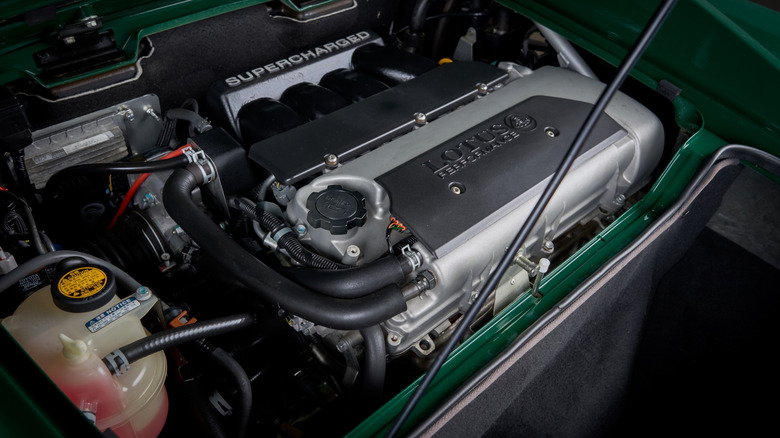
The Image Engine/Shutterstock
While the nearly century-old Toyota’s loom factory beginnings may have been humble, the Japanese manufacturer now sits at the top of the food chain, claiming an enviable 10.7% of the global automotive market as of 2023.
Advertisement
Toyota’s cars have undoubtedly been the main driving force on its road to global domination, but they were ably aided by the excellent engines it’s built over the years. These engines may not have the romance of a big, throbbing V8, but units like the high-performance 2JZ-GTE and ubiquitous 1ZZ-FE have made a name for themselves over the years for their performance and reliability.
These Toyota engines are, of course, best associated with the company’s cars. The Toyota Supra, MR2, and the many generations of the Corolla have all used the company’s engines, often to great effect. But Toyota hasn’t shied away from providing its engines to other carmakers, either. Sure, it’s not necessarily common, but a handful of non-Toyota cars have packed Toyota power under the hood over the years. Read on to find out what they are.
Advertisement
Lotus Elise (2004 – 2021)

Fauzan Fitria/Shutterstock
If there’s one car most gearheads associate with Lotus, it’s the Elise. Debuting in 1996, the Elise’s vaunted Lotus purity and simplicity made it a hit with reviewers and customers alike, selling an impressive 12,000 units in its first run — even with the fault-prone Rover K-Series in the engine bay.
Advertisement
Lotus persisted with the Rover engine for the first few years of the Series 2, but it introduced Toyota’s 189 hp 2ZZ-GE to the Elise 111R in 2004. The base Elise still used the Rover engine, but not for long: Lotus released a 134 hp, 1ZZ-GE-powered, entry-level Elise S in 2006. Lotus then slapped a supercharger on the Elise R — formerly the 111R — to create the Elise SC in 2008. The supercharger pushed numbers to 218 hp and 156 lb-ft of torque — more than enough on a car weighing just over 2,000 pounds.
The Series 3 Elise debuted in 2011, and its first year was a transitional one. The Elise R and SC stayed, but the base model Elise now had the 1.6-liter 1ZR-FAE. 2012 saw the Series 3 lineup change again, with Lotus dropping the Elise R and SC in favor in favor of the 217 hp, 184 lb-ft Elise S, with a supercharged 2ZR-FE in the engine bay. Lotus continued using these engines for the next decade, culminating in the 245 hp Elise Sport 240 and 250 hp Cup 250 Final Edition models before it discontinued the Elise in 2021.
Advertisement
Lotus Exige (2004 – 2021)
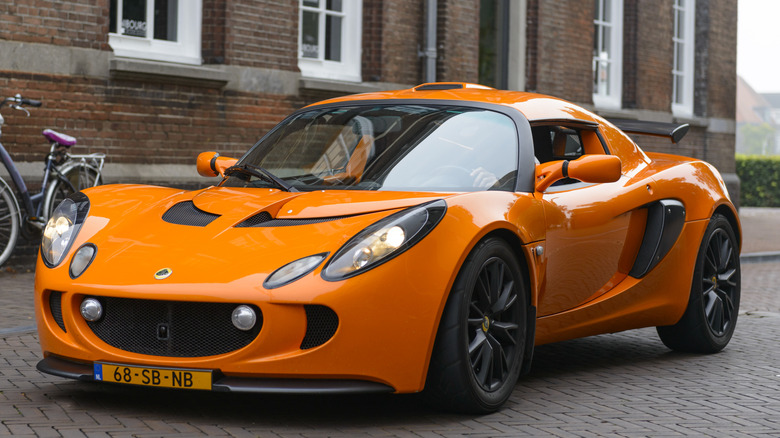
Sjo/Getty Images
Like its similarly styled, but not quite identical Elise sibling, the first-generation Exige launched with a Rover K-series engine under the hood. But that didn’t last long, and the track-minded hardtop switched to the Toyota 2ZZ-GE when Lotus introduced the Series 2 Exige in 2004. The original 2ZZ-powered Exige had 180 hp and 188 lb-ft of torque, good enough for an impressive 216 hp/ton power-to-weight ratio.
Advertisement
That was already pretty great, but not enough for Lotus: the company launched the supercharged and track-focused Exige S in 2006, which managed 218 hp from the 2ZZ via a supercharger. Lotus continued to work on the Exige S over the next few years, culminating in the lighter, even more hardcore Exige S 260 from 2009, which coaxed an even more impressive 257 hp from the same four-cylinder.
Lotus changed the powertrain setup for the Series 3 Exige, which debuted for the 2012 model year with a supercharged 345 hp 3.5-liter 2GR-FE V6 instead of the old four-banger. As you might expect, the following decade saw Lotus introduce a series of increasingly powerful Exige models, starting with the 375 hp Exige Sport 380 in 2016 and breaking past the 400 hp barrier with the Exige Cup 430 the following year. Lotus eventually gave the Exige a Dodge Last Call-style sendoff with three Final Editions: the 397 hp Sport 390 Final Edition, the 420 hp Sport 420 Final Edition, and the 430 hp Cup 430 Final Edition — the latter ranking as one of the best Lotus cars ever.
Advertisement
Lotus 2-Eleven (2007 – 2011)
A few years after introducing Toyota power to the Elise and Exige, Lotus took a page from its storied racing history and introduced the 2-Eleven, a hardcore, trackday-focused car built on the same platform as the Elige and Exige — just with a whole lot less. A windscreen? Unnecessary. Doors? No need. Creature comforts? Who cares?
Advertisement
What the 2-Eleven did have, however, was a lot of performance. It was significantly lighter than the contemporary Elise, with a dry weight of just under 1,500 pounds in its lightest configuration, and Lotus even managed to coax extra power from the supercharged 2ZZ-GE. The 2-Eleven made 252 hp and 179 lb-ft, a big leap over the 218 hp Elise SC. Lotus also offered a track-only Track Pack with upgrades such as a more aggressive front splitter, track-only ECM, a carbon fiber rear wing, and a straight-pipe exhaust.
The Track Pack-equipped 2-Eleven wasn’t the most hardcore version of the two-seater, either. The 2009 2-Eleven GT4 Supersport was even crazier, boasting a range of race-ready upgrades such as stiffer springs, higher-quality rear toe links, semi-slick tires, and a full rollcage. But the GT4 Supersport also had more power, to the tune of 266 hp and 182 lb-ft of torque thanks to revised intake and exhaust systems. Lotus only built 10 GT4 Supersports for its initial 2009 run, and it’s unclear how many more units Lotus built afterward.
Advertisement
[Image by Brian Snelson via Flickr | Cropped and scaled | CC BY 2.0]
Lotus 3-Eleven (2016 – 2018)
Trackday maniacs who thought the Series 3 Exige S wasn’t hardcore enough got a treat in 2015, when Lotus revealed the 3-Eleven at the 2015 Goodwood Festival of Speed. The 3-Eleven was a road-legal, stripped-down take on the Exige and Elise platform, with resin body panels and a brutally minimalist interior. Lotus offered the initial 3-Eleven in Road and Race forms, with the latter sporting a large rear wing and slick, track-ready tires — and no manufacturer warranty.
Advertisement
Power also differed between the two versions of the 3-Eleven, even though both used the same 3.5-liter, Edelbrock-supercharged Toyota 2GR V6. The Road version produced 410 hp and 302 lb-ft of torque, while the Race turned things up to a frankly crazy 460 hp and 387 lb-ft. Not supercar-bothering numbers, sure, but the 3-Eleven Race had a dry weight of just under 2,000 pounds — which meant it could go from 0 to 60 mph in 2.9 seconds.
Only 311 hand-built 3-Elevens left the factory during its initial run. But, as with most of its cars, Lotus couldn’t resist taking another stab at the 3-Eleven just a few years later. The company launched the 3-Eleven 430 in 2018, with the 430 hp Toyota V6 previously used in the Exige Cup 430 and more downforce — both of which helped it reclaim the Lotus test track lap record from said Exige. Lotus only built 20 units of the 3-Eleven 430.
Advertisement
[Image by Alexander-93 via Wikimedia Commons | Cropped and scaled | CC BY-SA 4.0]
Lotus Evora (2009 – 2021)
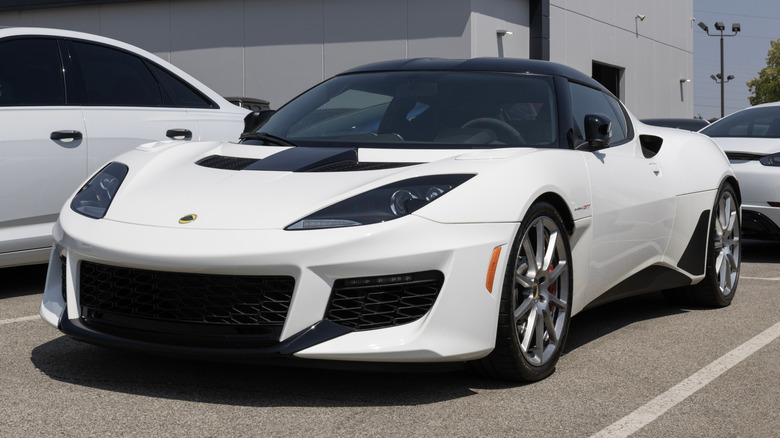
Jonathan Weiss/Shutterstock
Lotus’ Evora shared an obvious family resemblance to the Elise and Exige, with one major differentiating factor when it debuted in 2009: the seating arrangement. Unlike its siblings, the Evora was a mid-engined 2+2, with enough room in the back for kids, groceries, or luggage. Not quite a full-on four-seater, admittedly, but certainly a boon for those who needed the extra space.
Advertisement
The Evora was also the only V6-powered Lotus at its launch — the V6 Series 3 Exige wasn’t due for another few years. As on the contemporary Elise and Exige, the Evora’s V6 was a Toyota powerplant, namely the 3.5-liter 2GR-FE. The engine, with some minor Lotus tweaks, produced 276 hp and 258 lb-ft of torque. But the company wasn’t done: The Evora S debuted in 2010 with a supercharged 2GR under the hood making 345 hp and 295 lb-ft of torque — and even that wasn’t enough for Lotus.
Five years after the Evora S, Lotus launched the 400 hp Evora 400, with the extra power coming from an intercooled Edelbrock supercharger. Power climbed another 10 hp in 2016’s Evora Sport 410, eventually peaking with the limited-to-60 Evora GT430 and GT430 Sport. These had 430 hp thanks to upgrades such as a tweaked ignition, fuel map, and cam timing. Lotus ceased production of the Evora in 2021.
Advertisement
Lotus Emira (2022 – present)
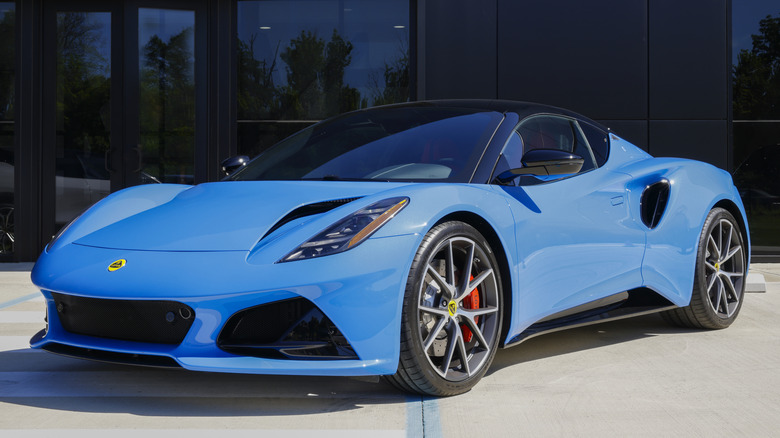
Jetcityimage/Getty Images
The Lotus Emira debuted in 2022 not just as a successor to the firm’s discontinued Elise, Exige, and Evora models, but also as the company’s final farewell to the internal combustion engine. Even as Lotus looked to its electric future with Eletre, the Emira held on to something from the past: the 3.5-liter Toyota V6.
Advertisement
The 2022 Emira First Edition, as Lotus called it, launched with the same supercharged Toyota 2GR-FE that had featured in the Evora and Exige Series 3. Unfortunately, new emissions regulations meant that the 3.5-liter had slightly less power than before, with Lotus claiming 400 hp and 310 lb-ft of torque from the engine. This was a slight reduction from the 400-plus hp peaks seen in the older cars like the 430 hp Evora GT430, but the drop in power certainly didn’t bother our own Alistair Charlton when SlashGear reviewed the Emira.
Unlike all of Lotus’ cars since the Series 2 Elise and Exige, though, the Emira isn’t exclusively Toyota-powered. Lotus’ announcement also revealed that it would offer a Lotus-designed, AMG-built, turbocharged 2.0-liter engine in the car, although it wasn’t available at launch. The AMG eventually debuted in 2023, making 360 hp and 317 lb-ft of torque and impressing reviewers with its performance and character. Lotus continues to offer both engines in the Emira as of 2024.
Advertisement
Chevrolet Nova (1985 – 1988)
Chevy’s Nova line started life as a trim level for the 1962 Chevy II before graduating into a standalone model in 1969, eventually birthing the Nova SS 396 L78, one of the most iconic Chevys from the 1970s. But as with many of its muscle car brethren, a shifting market and tighter emissions regulations meant the Nova muscle car died out in the early 1970s — with successive generations becoming less and less interesting. The fourth-generation Nova from 1975 was decent — not necessarily spectacular, but it at least lived up to its heritage by packing an American-built engine under the hood. The fifth-generation Nova, however, was a huge departure.
Advertisement
Chevy’s mid-1980s Nova was the first fruit of a GM-Toyota partnership called New United Motor Manufacturing Inc. (NUMMI). The result? A Chevrolet-branded Toyota Corolla, with the original’s 1.6-liter Toyota 4A-LC engine along for the ride.
The 4A-LC put out 74 hp, a far cry from its muscle car predecessors. Sure, its 30 mpg in the city was likely the more important figure for most buyers, but it was still a sign of how far the Nova had fallen. Things changed ever so slightly in 1988 when Chevrolet released the 110 hp Toyota 4A-GE-powered Nova Twin-Cam, which, while not on par with the ’70s Novas, still has its fans. The Twin-Cam was unfortunately short-lived: Chevy only built 3300 that year before retiring the Nova name at the end of 1988.
Advertisement
[Image by MercurySable99 via Wikimedia Commons | Cropped and scaled | CC BY-SA 4.0]
Geo/Chevrolet Prizm (1990 – 2002)
The family-friendly four-door Nova was gone by the end of the ’80s, but GM and Toyota hadn’t given up the idea of building an affordable, mass-market four-seater. The difference this time, was that GM had given up trying to market it under the Chevrolet brand name. Geo was a brand designed to attract import buyers, GM used it to continue marketing an American version of the Toyota Corolla: This time called the Prizm, it was announced in 1989 for the 1990 model year.
Advertisement
As it did with the fifth-gen Chevrolet Nova, GM and Toyota opted to stick with Toyota engines for the Geo Prizm, thankfully with a bit more power. The standard Prizm and Prizm LSi had the 102 hp 4A-FE engine, while the GSi sported a 130 hp 4A-GE engine, serving as something of a spiritual successor to the Nova Twin-Cam. GM and Toyota dropped the 4A-GE-powered GSi for 1993, replacing it (in a way) with the 1.8-liter 7A-FE, available in the Prizm LSi.
GM decided to stop using the Geo brand in 1996, releasing the third-generation Prizm as a Chevrolet instead. The 1998 Prizm debuted with a more rounded design and the 120 hp 1.8-liter Toyota 1ZZ-FE engine under the hood paired with a five-speed manual. GM opted not to offer an alternative engine on the higher-spec LSi, and both models used the 1ZZ-FE until GM dropped the Prizm after the 2002 model year.
Advertisement
Pontiac Vibe (2002 – 2010)
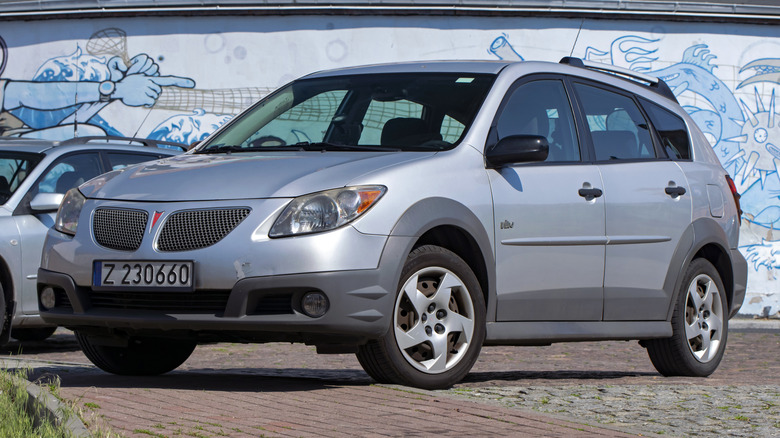
Tramino/Getty Images
The Pontiac Vibe marked the end for two entities, although one is probably more fondly remembered than the other. Firstly, it was the final GM-branded, NUUMI-built car. Secondly, it’s one of the last-ever cars to bear the Pontiac name, and one of the two to make it into the 2010 model year — the other being the Pontiac G6.
Advertisement
As with GM’s earlier NUUMI cars, this was a rebadged Japanese car. More specifically, the Vibe was a Toyota Matrix with a different logo and name. The two shared most components, including 1.8-liter 1ZZ-FE and 2ZZ-GE engines, with the latter’s 180 hp coming standard on the Vibe GT. The Vibe was front-wheel-drive as standard, but owners could also go for an all-wheel-drive model if they desired the extra traction.
GM launched the second-generation Vibe in 2007 as a 2009 model, with updated styling and engine options, although it was still essentially a Toyota Matrix. GM and Toyota also ditched the ZZ engines, but the Vibe remained an American car with a foreign engine: In place of the 1ZZ and 2ZZ engines were the 1.8-liter 2ZR-FE, which made 132 hp, and the 2.4-liter, 150 hp 2AZ-FE. The second-generation Vibe didn’t get much chance to succeed, though: GM discontinued the Vibe in 2009, one of many tough decisions it had to make due to its 2009 bankruptcy, which included pulling the plug on Pontiac and NUUMI.
Advertisement
Spyker B6 Venator (2013)
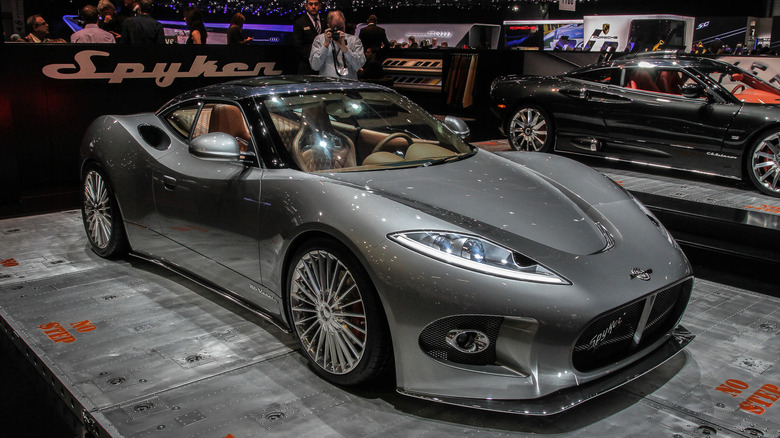
Gerlach Delissen – Corbis/Getty Images
Lotus’ mid-engined offerings were pretty exotic as far as Toyota-powered cars go, but Dutch company Spyker’s B6 Venator from the early 2010s had it beat — or would have, at least, had Spyker ever built it for real. Spyker announced the mid-engined B6 Venator at the 2013 Geneva International Motor Show, with plans to start building the car in early 2014.
Advertisement
The B6 Venator was a mid-rear-engined, two-seater sports car powered, at the time, by an unspecified V6 making around 375 hp. While Spyker didn’t initially disclose the origin of its V6, journalists later found out that Spyker planned to source the engine from Lotus. And the only 300-plus hp V6 Lotus had to offer at the time would have been the Toyota unit in the Evora and Series 3 Exige.
Of course, Lotus hadn’t released a 375 hp car in 2013. It’s unclear whether Spyker planned to modify the V6 to squeeze that 375 hp out of the engine or whether Lotus had already started experimenting with the engine changes that would later give birth to the 375 hp Exige Sport 380. Either way, the Venator’s proposed engine would have resulted in a pretty fast car, considering its carbon fiber body and aluminum chassis; the least future buyers could expect, really, considering its roughly $150,000 starting price. Sadly, the B6 Venator proved to be another supercar that never made it to production, so we never found out how quick it was.
Advertisement
Lexus and Scion
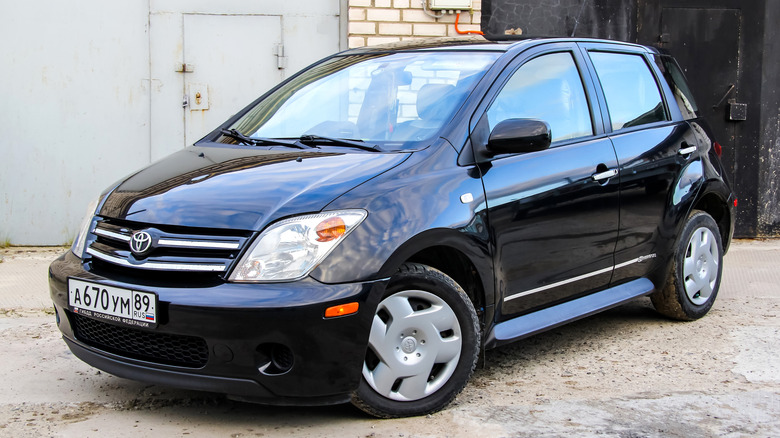
Art Konovalov/Shutterstock
We’ve focused on fully non-Toyota cars for this list, but it wouldn’t be complete without at least mentioning Lexus and Scion. While they’re not badged as Toyotas, both brands are — or were, in Scion’s case — divisions of Toyota; for our money, that makes Lexus and Scion’s offerings pretty much Toyotas, just under a different name.
Advertisement
A bit of history: Toyota launched Lexus to market its Luxury brands in 1988 with the BMW- and Mercedes-rivaling Lexus LS400, which had the legendary 3.8-liter 1UZ-FE V8 under the hood. Toyota owns Lexus to this day, and the two companies’ cars often share components and platforms — including engines. Even the iconic Lexus LF-A sported a Toyota engine, namely the 1LR-GUE, which the corporation developed in conjunction with Yamaha.
Scion, on the other hand, was an early 2000s attempt to appeal to younger buyers. The first two Scion cars — the xA and xB — debuted at the 2003 Los Angeles Auto Show, and both had Toyota’s 1.6-lite 1NZ-FE under the hood. Scion continued to use Toyota engines in most of its future cars, although there were some exceptions: the Scion iA, for example, was a rebadged Mazda 2, while the sporty Scion FR-S technically had a Subaru engine, albeit one that was the product of a Subaru-Toyota partnership. By and large, though, Scion cars used Toyota engines until the company dissolved the Scion brand in 2017.
Advertisement